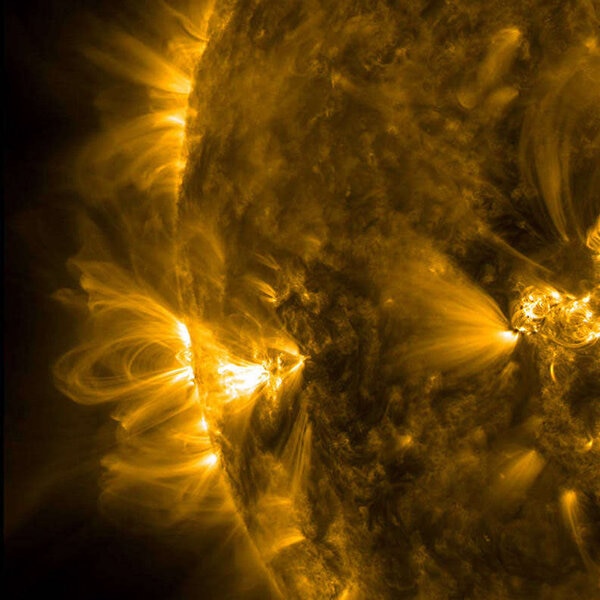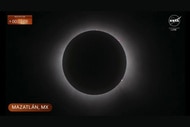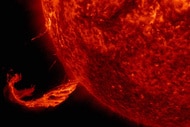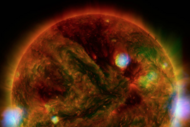Create a free profile to get unlimited access to exclusive videos, sweepstakes, and more!
Understanding the Sun's Solar Cycle and Coronal Mass Ejections (CMEs)
The Sun goes through a violent midlife crisis every 11 years.
Director Roland Emmerich’s 2022 sci-fi disaster flick Moonfall (on SYFY this month) opens on a 2011 space shuttle mission to repair a satellite in orbit. During the mission, astronauts encounter a swarm of alien gadgets which attack before hiding themselves inside the Moon. Surviving astronaut Brian Harper (Patrick Wilson) takes the fall for the disaster, gets fired from being a spaceman, and NASA blames the incident on a solar flare.
Here in the real world, there is a fortunate lack of alien robots inside the Moon (as far as we know) but flares and other solar events are very real, potentially destructive, and on the rise. Over the next year or so, we can expect to see an increase in solar flares, coronal mass ejections (CMEs), and auroras as we crest the peak of Solar Cycle 25.
For More on the Sun:
How Solar Explosions Unleash X-Ray Auroras on Mercury
Meet Steve, a Rare Atmospheric Light Show in a Sky Near You
The Sun Opened Up a Solar Wind-Spewing Coronal Hole 60 Times the Size of Earth
What Is Solar Cycle 25?
In September of 2020, a panel of experts at the National Oceanic and Atmospheric Administration (NOAA) announced that we had officially entered Solar Cycle 25. Roughly every 11 years, the Sun’s magnetic field goes through a regular and repeating cycle, during which the star’s magnetic poles switch places.
The Sun’s cyclical nature was first uncovered by German astronomer Heinrich Schwabe in the early 19th Century. By tracking the movements and frequency of dark spots on the Sun’s surface, he discovered that the Sun rotates on its axis every 27 days and goes through an 11-year magnetic field cycle. Since then, we’ve tracked 24 complete cycles and have entered another, which is why we call it Solar Cycle 25.
Deep in the core of the Sun, atoms of hydrogen are fusing together and releasing massive amounts of energy which slowly creeps its way to the surface over the course of thousands of years. The journey from the center of the Sun to the surface cuts through an ocean of dense hydrogen gas in plasma form. The bubbling and boiling generates an intense magnetic field which is constantly twisting around itself. Sunspots form in places where the magnetic field is particularly strong, and we can get a feel for how active the Sun is by the number of spots on its face.
Each 11-year solar cycle begins and ends at solar minimum, a time when the Sun’s activity is at its lowest, with the highest level of activity perched in the middle. At solar minimum there may be only a few sunspots, or none, for weeks at a time. At maximum there might be hundreds of sunspots dotting the solar surface.
When Will Solar Maximum Happen and How Strong Will It Be?
When astronomers first announced the beginning of Solar Cycle 25, they predicted a relatively calm cycle with a peak in July 2025. Over time, however, astronomers have continued to make measurements, gather data, and refine the models. Today, astronomers are predicting that solar maximum will occur earlier and be stronger than prior projections suggested.
In fact, solar maximum may have already begun, and we just don’t know it yet. That’s because determining solar maximum and minimum is a game of comparison. We can’t know we’ve hit peak sunspot activity until we see the numbers start to fall; we can’t really know we’ve seen solar maximum until it’s walking out the door. At present, solar maximum is predicted to occur at some point between January and October 2024.
Tracking the solar cycle is largely achieved by counting or estimating the number of sunspots at any given time, and astronomers do that by assigning a sunspot number. The sunspot number is an estimate of the Sun’s activity and is determined with a simple formula. Observers count the number of disturbed regions or sunspot groups and multiply that total by 10, then they add the number of individual sunspots, and then multiply all of that by a factor based on observing conditions.
The formula for calculating sunspot activity is R = K(10G + S), where G is the number of sunspot clusters, S is the number of individual spots, and K represents observation limitations or bias. When Solar Cycle 25 was originally announced with a maximum expected in the summer of 2025, the estimated peak sunspot number was 115, considerably milder than average. The revised models with an earlier 2024 solar maximum put the sunspot peak between 137 and 173, stronger than previous estimates but still lower than the average of 179.
During solar maximum, when sunspots are at their most excited, we’re likely to see an uptick in solar flares and CMEs, some of which will undoubtedly be aimed in our direction.
What Is a Coronal Mass Ejection (CME)?
At a distance of roughly 93 million miles from here, you might think that the Sun can’t do much except shine on us, but you’d be mistaken. The Sun is far away, but it’s also big and powerful. As the Sun’s magnetic field twists itself up in knots, it gets tangled up with plasma and puts itself under tremendous stress. Sometimes, the magnetic field sees a simple way to reconfigure itself and relieve some stress, but it requires ditching some of its mass overboard.
When magnetic field lines rapidly change from one configuration to another, sometimes bits of the field and the plasma bound up in it get cut off. If they don’t collapse back to the surface and get reabsorbed, they can get flung out into space in the form of a solar flare and accompanying CME. These explosions of plasma carry billions of tons of charged particles away from the Sun. They travel at speeds between 250 and 3,000 kilometers per second, that’s a blistering 560,000 to 6.7 million miles per hour, topping out at about 1% the speed of light. At those rates, CMEs can cover the 93 million miles to Earth in a matter of hours or days.
As they move through space they spread out like a rippling wave, blasting anything in their solar wake with a tsunami of energized solar particles. Along the way, they create a shockwave through space, snatching up nearby particles and accelerating them toward their target. And it’s that relationship that helps us detect them.
CMEs are typically detected by satellites like the Deep Space Climate Observatory (DSCOVR), which is orbiting at Earth’s L1 Lagrange point. As the shockwave moves toward us, it compresses the interplanetary magnetic field in front of it, and that compression can be detected by DSCOVR, giving us at least a little bit of warning for an impending solar sucker punch.
Catch Moonfall March 21 at 11:01 p.m. ET and March 22 at 10:15 a.m. ET, on SYFY or streaming now on the SYFY app.



















